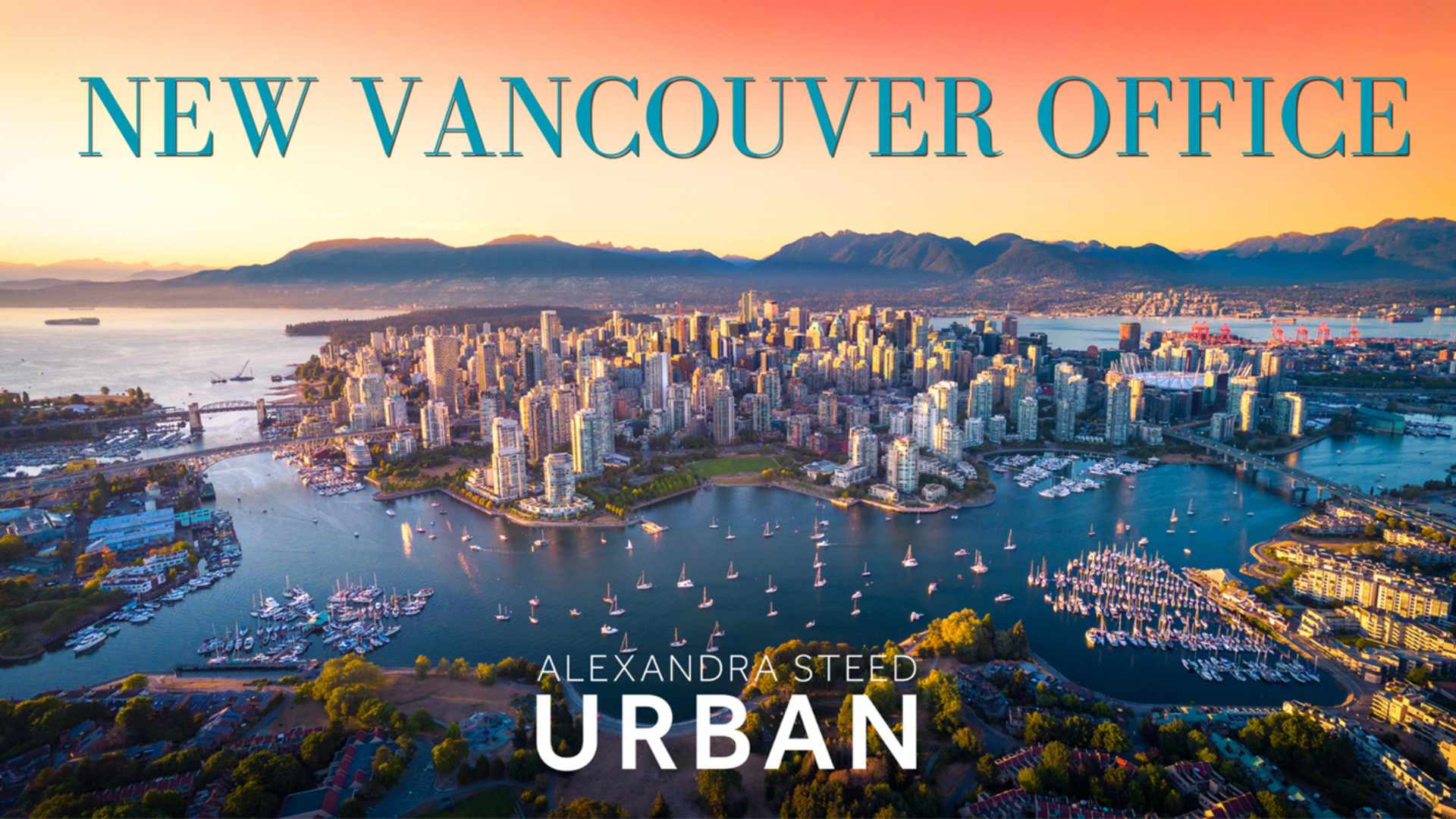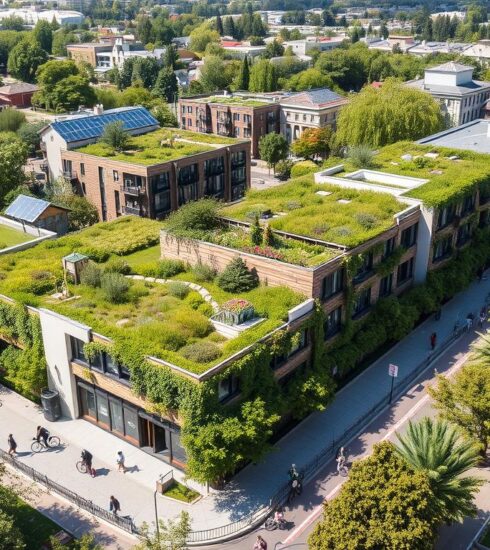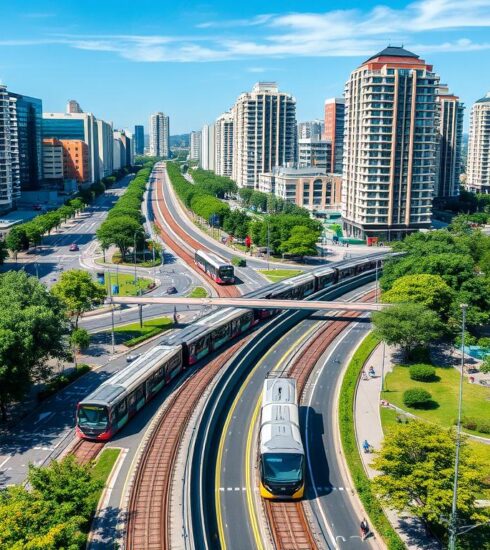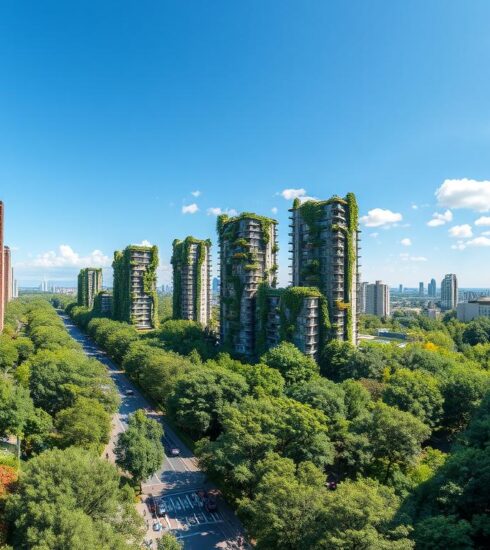Vancouver’s Walkable Wonders: Urban Design Secrets Behind a Pedestrian Paradise
- Jackie De Burca
- October 20, 2024
Vancouver’s Walkable Wonders: Urban Design Secrets Behind a Pedestrian Paradise
Vancouver, the crown jewel of Canada’s Pacific Northwest, has transformed itself into a veritable pedestrian paradise, captivating visitors and residents alike with its meticulously planned urban design.
The city’s walkable neighbourhoods, seamlessly integrated with natural wonders, paint a vibrant tapestry of cultural riches and sustainable living. From the bustling streets of historic Chinatown1 to the lush, sprawling expanse of Stanley Park1, Vancouver’s urban landscape offers a diverse and engaging walking experience that celebrates the democratic art of exploring a city on foot.
At the heart of Vancouver’s walkable wonders lies a deliberate focus on creating a people-centric urban environment, where the needs of pedestrians take precedence over the dominance of automobiles. This shift in urban planning philosophy has given rise to a city that fosters community, connectedness, and a deep appreciation for the natural world – a true pedestrian paradise that invites visitors to discover its secrets through the simple act of exploration on foot.
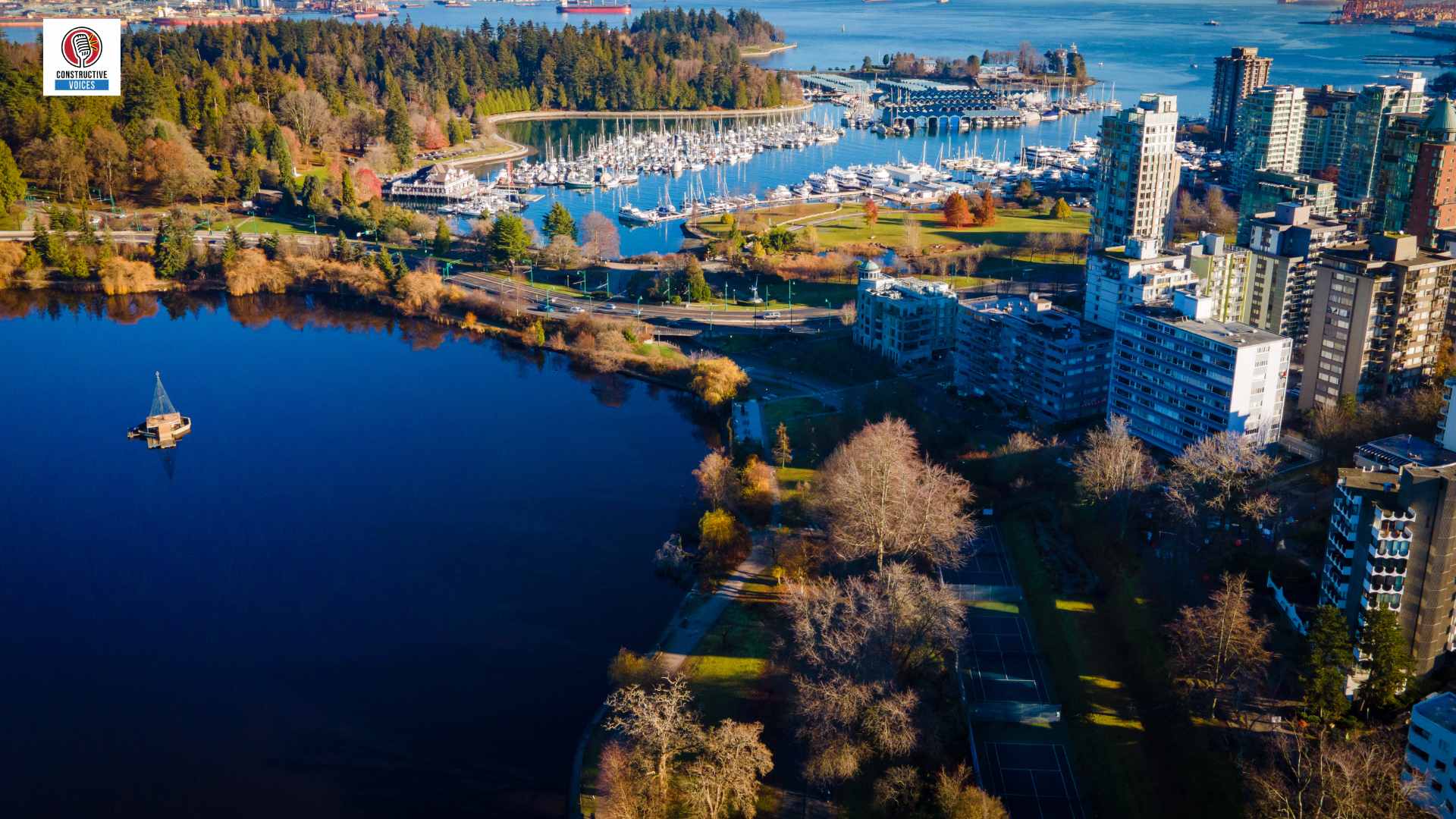
Key Takeaways
- Vancouver boasts the third-largest Chinatown in North America, showcasing the city’s cultural diversity1
- Stanley Park, covering 1000 acres, is a testament to the city’s commitment to green spaces1
- The Capilano Suspension Bridge, spanning 450 feet and suspended 230 feet above the river, is an impressive feat of engineering1
- Granville Island is a vibrant cultural hub with a thriving arts scene1
- Robson Street offers a diverse shopping experience with a mix of designer boutiques and local shops1
The Essence of Walkability in Vancouver
Walkability in Vancouver transcends mere pedestrian-friendly streets; it’s a democratic art form of urban living2. The city’s approach to walkability reflects the ideas of urban theorists like Jane Jacobs, emphasising the importance of diverse, vibrant streetscapes. Factors such as sidewalk design, mixed-use developments, and public spaces contribute to Vancouver’s exceptional walkability, which is renowned globally3.
“Landscape can overcome many of our current environmental, social, and economic challenges when we focus on it and understand its marvelous benefits.” – Alexandra Steed – visit her website
Defining Walkability
Walkability is the extent to which an urban environment encourages walking for transportation, recreation, and social interaction. In Vancouver, this concept is woven into the fabric of the city, creating a seamless experience for pedestrians2. The city’s commitment to walkability is evident in its 22 official neighbourhoods, further divided into 50 walkable areas using detailed criteria2.
Factors Affecting Walkability
Several elements contribute to Vancouver’s exceptional walkability, including:
- Pedestrian-friendly infrastructure, such as wide sidewalks, well-maintained crosswalks, and traffic-calming measures
- Mixed-use developments that integrate residential, commercial, and recreational spaces, reducing the need for car-based transportation
- Abundant public spaces, parks, and green areas that invite exploration on foot
The Benefits of a Walkable City
The benefits of Vancouver’s walkable urban design are manifold2. It promotes public health by encouraging physical activity, fosters stronger community bonds, and reduces carbon emissions by minimizing reliance on private vehicles3. Vancouver’s commitment to sustainable walking tours, scenic routes, and sustainable tourism initiatives further solidifies its reputation as a model for walkable cities worldwide.
“Vancouver’s walkability and mixed-use neighbourhoods contribute to its reputation as a leader in urban sustainable practice and planning.”3
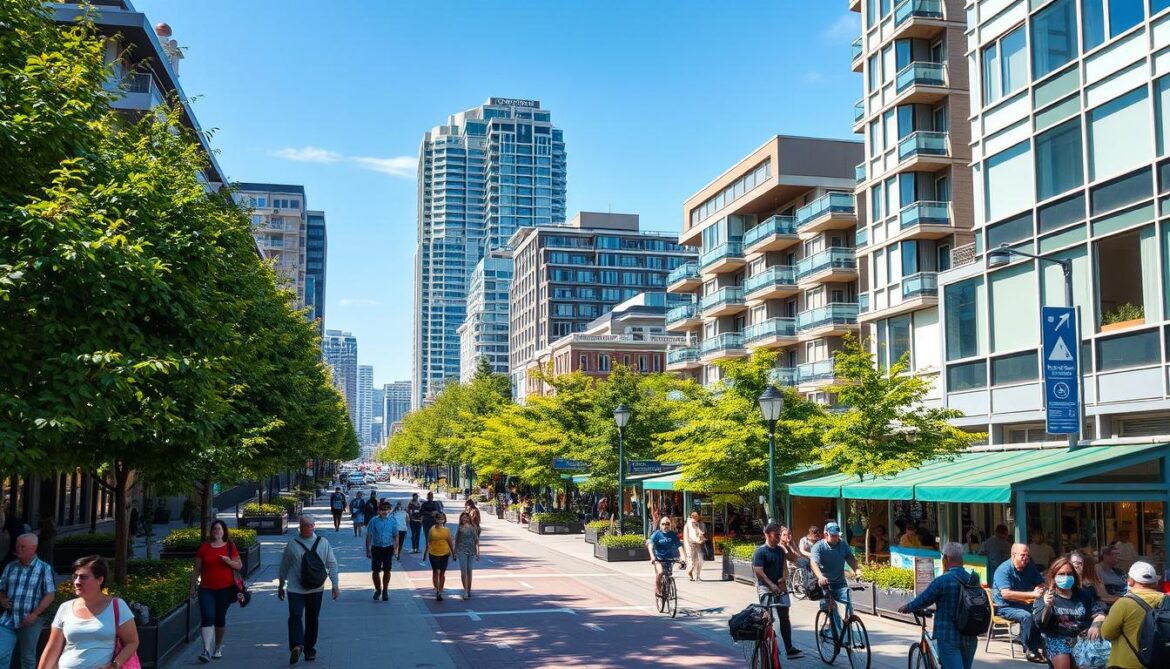
Vancouver’s approach to walkability is the result of a long-term commitment to urban design that prioritises pedestrians and community-centric development. The city’s journey has been marked by pivotal moments, such as the successful opposition to freeway projects in the 1960s and 1970s, which paved the way for a more walkable and livable urban landscape3.
As Vancouver continues to evolve, its dedication to walkability remains a cornerstone of its urban planning, ensuring that the city remains a model for sustainable and inclusive urban development4.
Historical Context: Vancouver's Urban Development
Vancouver’s urban landscape has been meticulously shaped by visionary planners and influential urban theorists5. The city’s evolution from a small settlement to a thriving, walkable metropolis is marked by key historical milestones that have left an indelible mark on its architectural and cultural identity.
Evolution of Vancouver's City Design
The establishment of Stanley Park in 1888 and the preservation of historic neighbourhoods like Gastown have been pivotal in shaping Vancouver’s distinctive urban character6. Granville Island, once an industrial wasteland, has since transformed into a vibrant hub of arts, culture, and gastronomy, showcasing the city’s commitment to urban renewal and adaptive reuse.
Key Historical Milestones
Vancouver’s urban development has been punctuated by several notable events and landmarks5. The Hidden Brick Company, founded in 1871, produced an estimated 60 million rectangular clay blocks that were instrumental in the city’s early construction5. Esther Short Park, the oldest public square in Washington state, covers five acres in downtown Vancouver, while the Wendy Rose statue and the Ilchee statue along the Waterfront Renaissance Trail pay homage to the city’s industrial and indigenous heritage, respectively5.
Influential Urban Theorists
Urban theorists such as Jane Jacobs have had a significant influence on Vancouver’s approach to creating liveable, walkable communities6. Her ideas and philosophies have been instrumental in shaping the city’s urban design, with a focus on preserving historic neighbourhoods, encouraging mixed-use developments, and prioritising pedestrian-friendly infrastructure.
The5 nine-foot Captain George Vancouver statue, standing at the intersection of 6th and Esther Street, serves as a constant reminder of the city’s namesake and its rich history.

“Vancouver’s urban development has been a testament to the power of visionary planning and the influence of pioneering urban theorists. The city’s evolution from a small settlement to a vibrant, walkable metropolis is a true testament to the transformative potential of urban design.”
Integrating Nature into Urban Settings
Vancouver is renowned for seamlessly blending urban development with natural beauty7. The city’s commitment to sustainability is evident in its numerous parks and green spaces, which not only contribute to its reputation as a walkable metropolis but also enhance the overall well-being of its residents and visitors8.
Parks and Green Spaces
At the heart of Vancouver’s green spaces lies the iconic Stanley Park, a sprawling 1,000-acre rainforest oasis within the city7. Boasting stunning views of the city and the surrounding mountains, this urban sanctuary attracts visitors seeking tranquility amidst the bustling urban landscape9. The city’s commitment to integrating nature into its urban fabric is further exemplified by its diverse network of parks and green spaces, each offering a unique character and experience for residents and tourists alike7.
Biodiversity and Urban Resilience
Vancouver’s dedication to sustainability extends beyond its impressive green spaces, with a focus on promoting biodiversity and urban resilience8. The city’s Greenest City Action Plan has set ambitious goals to reduce its environmental footprint and position Vancouver as a global leader in sustainable living8. Through careful urban planning and community engagement, the city is working to ensure that its natural ecosystems and biodiversity thrive, contributing to its long-term resilience8.
Community Engagement in Nature Design
Engaging the community in the design and stewardship of urban green spaces is a key priority for Vancouver8. Residents and visitors alike are invited to participate in the planning and maintenance of parks, gardens, and other natural areas, ensuring that these spaces cater to the needs and preferences of the local population8. This collaborative approach not only fosters a sense of ownership and pride among the community but also helps to strengthen the bond between people and the natural environment they share8.
Vancouver’s commitment to integrating nature into its urban landscape is a testament to its vision for a sustainable and livable future8. By prioritizing green spaces, biodiversity, and community engagement, the city continues to set an example for urban centres around the world, inspiring others to embrace the transformative power of nature-based solutions8.
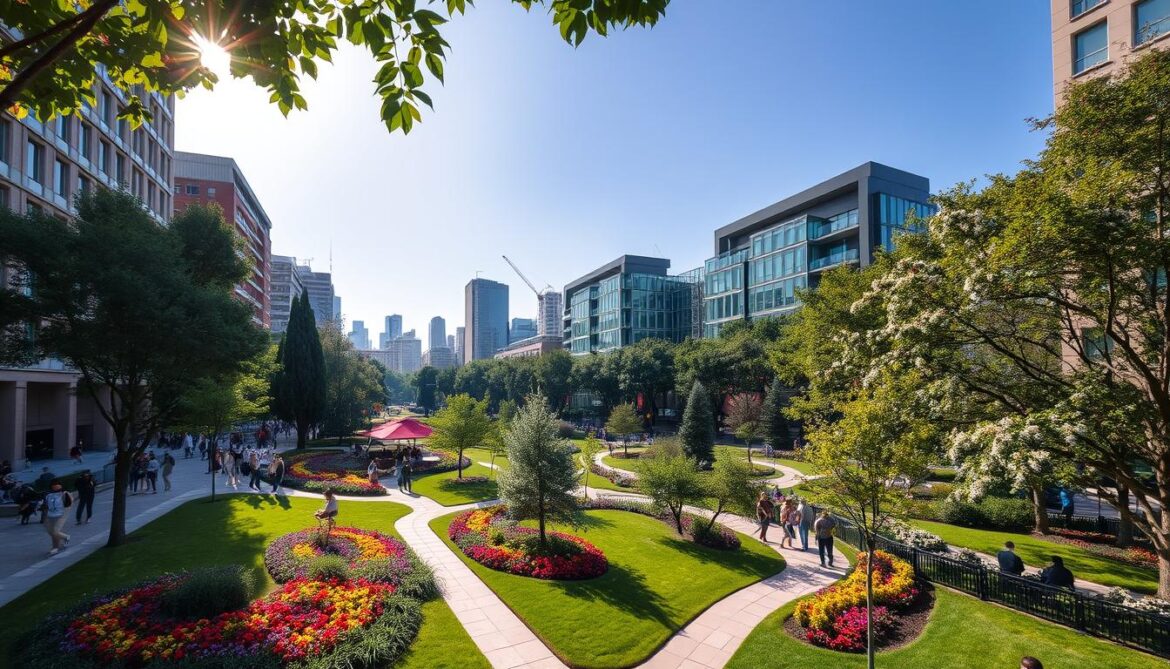
| Key Highlights | Details |
|---|---|
| Stanley Park | A sprawling 1,000-acre urban oasis, offering breathtaking views of the city and surrounding mountains9. |
| Greenest City Action Plan | Vancouver’s ambitious plan to reduce its environmental footprint and become the greenest city in the world by 20208. |
| Community Engagement | Residents and visitors actively participate in the design and stewardship of urban green spaces, ensuring they meet the needs of the community8. |
“Vancouver’s commitment to integrating nature into its urban landscape is a testament to its vision for a sustainable and livable future.”
Public Transport: A Complement to Walkability
Vancouver’s public transport system complements its walkable design, enhancing accessibility and connectivity between different areas10. The integration of transit with pedestrian-friendly zones allows for seamless movement throughout the city10. Successful case studies demonstrate how public transport and walkability work together to create a more sustainable and efficient urban environment.
Enhancing Access with Transit
A well-integrated public transport network is essential for improving accessibility in a walkable city10. Vancouver’s SkyTrain system, for example, operates at high speeds and decreases operating and capital costs per passenger as usage rises over time, making it a competitive option alongside streetcars10. Furthermore, cities like Phoenix and Houston have demonstrated that light rail systems running alongside arterial streets can provide better capacity and ridership compared to local bus routes10.
Connectivity Between Walkable Areas
Connecting walkable areas through public transport is crucial for fostering sustainable tourism and urban exploration11. Cities like Vancouver and Mexico City have implemented “car-free” days and street closures, allowing pedestrians, cyclists, and other non-motorised users to freely enjoy recreational and social experiences11. These initiatives enhance the connectivity between walkable zones and promote a more inclusive, community-driven urban environment.
Case Studies: Successful Integration
Examining case studies of cities that have successfully integrated public transport and walkability can provide valuable insights10. San Jose’s light rail system, for example, showcases both successful and unsuccessful parts due to its design, with varying ridership levels10. In contrast, Vancouver’s SkyTrain and the light rail systems in Phoenix and Houston demonstrate the benefits of integrating transit with pedestrian-friendly infrastructure10.
By combining the strengths of public transport and walkability, cities like Vancouver can create a more sustainable and efficient urban landscape that caters to the needs of both residents and visitors10. This synergistic approach not only enhances mobility but also fosters a sense of community and promotes a healthier, more environmentally conscious way of living11.

Architectural Highlights of Vancouver
Vancouver’s architecture plays a crucial role in shaping the city’s walkable and vibrant urban landscape. From iconic pedestrian-friendly buildings to innovative infrastructure, the architectural marvels of this West Coast metropolis captivate visitors and locals alike, offering a unique blend of heritage sites and urban exploration opportunities.
Iconic Pedestrian-Friendly Buildings
The city’s architectural jewels, such as the Vancouver Art Gallery, boast a design that seamlessly integrates with the surrounding streetscape, encouraging pedestrian engagement. Admission to this cultural hub costs £24 for adults, £20 for seniors, and £18 for students12. These buildings, with their welcoming public spaces and inviting facades, create a sense of place and foster a lively, walkable atmosphere.
Innovative Urban Infrastructure
Vancouver’s urban infrastructure also showcases its dedication to pedestrian-friendly design. The iconic steam clock in Gastown, built in 186712, stands as a testament to the city’s heritage and draws visitors to explore the charming cobblestone streets of this historic neighbourhood. Additionally, the 22-kilometre (13.5-mile) Vancouver Seawall12 provides a scenic and accessible route for pedestrians and cyclists, offering unparalleled views of the city’s natural beauty.
The Role of Mixed-Use Developments
Mixed-use developments, which combine residential, commercial, and recreational spaces, play a crucial role in creating vibrant, walkable neighbourhoods in Vancouver. These integrated communities, such as the bustling Granville Island13, encourage a diverse range of activities and interactions, fostering a sense of community and promoting a healthy, active lifestyle for residents and visitors alike.
| Architectural Highlights | Key Facts |
|---|---|
| Vancouver Art Gallery | • Cost of admission: £24 for adults, £20 for seniors, £18 for students12 |
| Vancouver Seawall | • Total length: 22 kilometres (13.5 miles)12 |
| Holy Rosary Cathedral | • Built in 188512 |
| Stanley Park | • Total area: 400 hectares (1,000 acres)12 |
| Vancouver Aquarium | • Over 70,000 aquatic animals12 |
| Brockton Point Lighthouse | • Designed and built in 191412 |
| Granville Island | • Attracts approximately 10.5 million visitors annually13 |
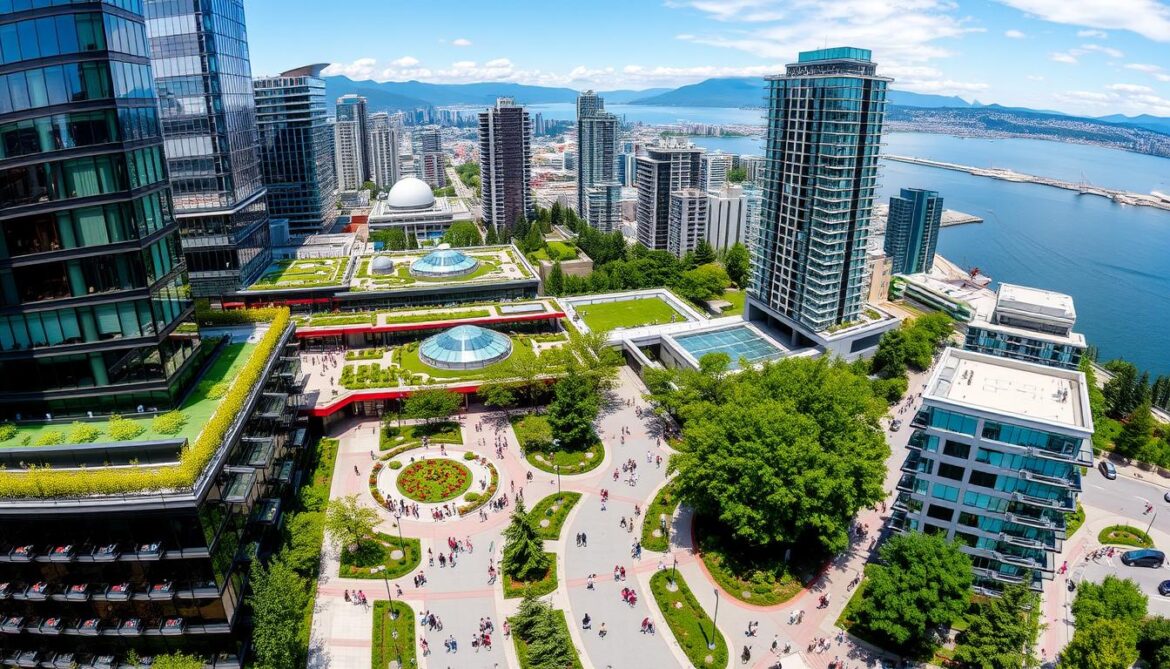
Vancouver’s architectural landscape is a testament to the city’s commitment to creating a pedestrian-friendly urban environment that seamlessly integrates heritage sites and innovative design. From iconic buildings to mixed-use developments, these architectural marvels invite residents and visitors alike to explore, discover, and immerse themselves in the rich cultural tapestry of this vibrant West Coast destination.
Alexandra Steed: Leading the Urban Design Revolution
As Vancouver prepares for a future of increased urban exploration and sustainable tourism, a renowned expert in urban design is set to make her mark on the city. Alexandra Steed, a prominent figure in the field of liveable, pedestrian-friendly spaces, is poised to open a Vancouver office in 2024, bringing her visionary approach to the city’s ongoing development14.
Background and Expertise
With a proven track record of creating vibrant, walkable communities, Alexandra Steed has established herself as a leading voice in the urban design revolution. Her expertise spans a range of disciplines, from architecture and landscape architecture to urban planning and community engagement. Steed’s holistic approach to urban development has earned her widespread recognition and respect within the industry14.
Opening of Vancouver Office in 2024
Steed’s decision to open a Vancouver office in 2024 is a testament to her belief in the city’s potential for urban exploration and sustainable tourism. By establishing a local presence, she aims to immerse herself in the unique challenges and opportunities that Vancouver presents, allowing her to tailor her design solutions to the city’s specific needs14.
Vision for Vancouver's Urban Future
Steed’s vision for Vancouver’s urban future is centred on creating a vibrant, pedestrian-friendly landscape that seamlessly integrates nature and community. She envisions a city where residents and visitors alike can freely explore, discover, and engage with their surroundings, fostering a deep appreciation for the city’s natural and built environments. Steed’s design approach prioritises sustainability, connectivity, and the enhancement of the urban experience for all14.
“Vancouver’s commitment to walkability and sustainable design aligns perfectly with my own vision for creating liveable, people-centric cities. I’m excited to contribute my expertise to the ongoing evolution of this remarkable city.”
Promoting Local Culture and Community
Vancouver’s walkable areas serve as vibrant hubs for celebrating the city’s rich local culture and fostering a strong sense of community. From public art installations to cultural events, these pedestrian-friendly zones showcase the diverse tapestry that makes Vancouver a truly unique destination.
Celebrating Local Art and Design
Vancouver is home to a thriving arts scene, with numerous galleries and museums that highlight the work of talented local and regional artists. The Vancouver Art Gallery is one of Canada’s largest art institutions, housing a vast collection of artworks from renowned local and international artists15. The UBC Museum of Anthropology showcases Indigenous art, artifacts, and cultural objects, with an emphasis on the rich Indigenous heritage of the Pacific Northwest, especially the First Nations of British Columbia15. The Vancouver Maritime Museum features exhibits on navigation, shipbuilding, marine exploration, and the coastal environment, and is home to the historic RCMP St. Roch ship15. The Bill Reid Gallery of Northwest Coast Art celebrates Indigenous art and culture, showcasing the works of acclaimed Haida artist Bill Reid and other contemporary Indigenous artists15. The Beaty Biodiversity Museum at UBC houses extensive collections of specimens, including fossils, insects, plants, and vertebrates, promoting learning about biodiversity and conservation15. The Vancouver Holocaust Education Centre is a museum and resource center focused on educating the public about the Holocaust and promoting understanding, remembrance, and human rights15. The Burnaby Heritage Village Museum offers a glimpse into early 20th-century life in the region through historic buildings, artifacts, and interpreters showcasing pioneer history15. The Nikkei National Museum & Cultural Centre, located in Burnaby, explores the history and contributions of Japanese Canadians, preserving and promoting Japanese Canadian heritage and culture15.
Initiatives for Community Development
The City of Vancouver and the local community actively collaborate to enhance the cultural and social fabric of the city. Since 2004, the City of Vancouver and the Clark County Mural Society have collaborated to create over 40 murals and nearly 20 displays of public art16. In 2022 and 2023, over 15 new murals were added to Vancouver’s downtown area16. Visitors can find a cluster of murals along Washington and Main Street, and the alleyway behind Kindred Homestead Supply off Main Street has been transformed into an outdoor gallery16. These initiatives, supported by organisations such as The City of Vancouver’s Culture, Arts & Heritage Commission and The Historic Trust, help to showcase the city’s local culture and creativity16.
Cultural Events in Walkable Areas
Vancouver’s walkable areas serve as the backdrop for vibrant cultural events that celebrate the city’s local heritage and diversity. Noteworthy public art installations in Vancouver include “Flying Umbrellas” in the downtown area, the Salmon Run Bell Tower in Esther Short Park, and the Ilchee Statue & Plaza on the east waterfront16. These outdoor spaces provide the perfect setting for community gatherings, festivals, and celebrations that bring residents and visitors together to experience the local culture and hidden gems of the city.
“Vancouver’s creative scene is supported by organizations such as The City of Vancouver’s Culture, Arts & Heritage Commission, and The Historic Trust, helping to showcase the city’s local culture and creativity.”16
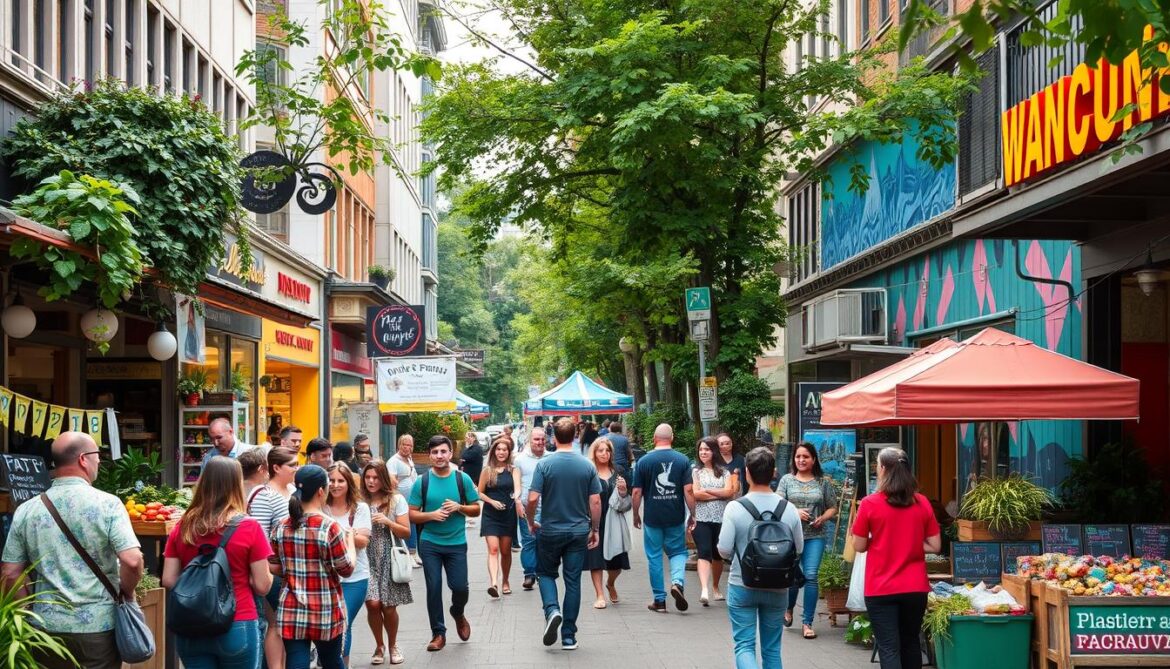
The Role of Policy in Urban Planning
Vancouver’s urban planning policies play a crucial role in promoting sustainable tourism and urban exploration. Current policies support pedestrian-friendly development and sustainable urban design, as the city aims to address the environmental impact of transportation17. However, challenges in legislation and implementation persist, requiring ongoing advocacy and collaboration between policymakers, urban planners, and the community.
Current Policies Supporting Walkability
The City of Vancouver’s Climate Emergency Action Plan (CEAP) sets ambitious goals to reduce carbon emissions by 50% of 2007 levels by 2030 and achieve carbon neutrality by 205017. A key focus of the CEAP is to lower the 39% of emissions from fossil-fuel vehicles, targeting a future where 90% of people live within an easy walking or biking commute of their daily needs, two-thirds of trips are carried out by active transportation and transit, and 50% of the kilometers driven are by zero-emissions vehicles17.
Barriers and Challenges in Legislation
Despite these policy initiatives, the transportation sector in Vancouver remains dominated by privately owned, conventionally fueled vehicles primarily used by single occupants17. Transformative changes in urban mobility are needed to address the city’s climate action challenges, as the focus has been more on practical, techno-managerial solutions rather than personal changes in social perceptions and political restructuring of transportation systems17.
Advocacy for New Policies
In 2023, the Province announced several pieces of legislation aimed at building more homes faster, shaping growth around transit hubs, and reducing red tape18. The Vancouver City-wide Plan is also being developed to guide the city towards 2050 and beyond, with opportunities for public feedback and participation through rezoning applications, advisory groups, and community involvement initiatives18. Advocates continue to push for innovative policies that further enhance Vancouver’s walkability and address the city’s sustainable tourism and urban exploration needs.
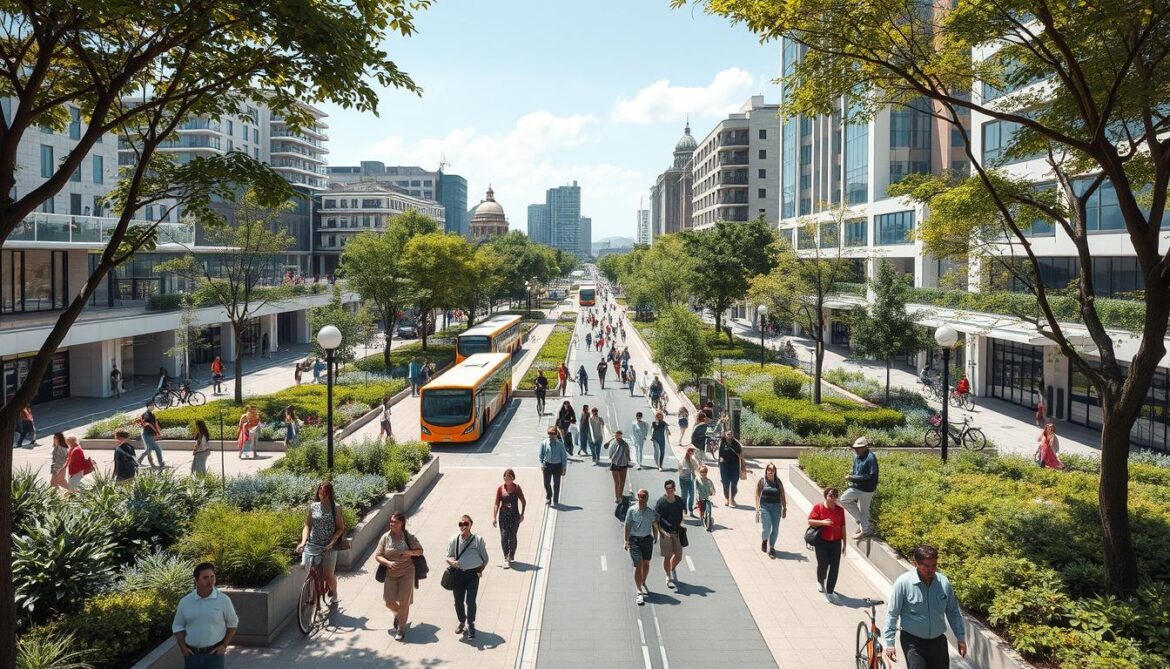
“The focus of climate action is predominantly on practical, techno-managerial solutions, with less emphasis on personal changes in social perceptions and political restructuring of transportation systems.”
Navigating the City: Infrastructure for Pedestrians
Vancouver’s pedestrian infrastructure is thoughtfully designed to enhance the walking experience for both residents and visitors. From well-maintained sidewalks to intuitive wayfinding systems, the city’s focus on creating a comfortable and secure environment for urban exploration is evident19.
Sidewalk Design and Maintenance
The city’s sidewalks are wide and well-separated from the flow of buses and cars, contributing to a pleasant downtown environment for walking19. Vancouver’s infrastructure team works tirelessly to ensure the proper functioning of the city’s essential services, including repairing sidewalks to provide safe pathways for pedestrians20.
Safety Features for Pedestrians
Pedestrian safety is a top priority in Vancouver, with the city’s infrastructure designed to protect walkers. Parking enforcement officers patrol the streets to help keep traffic moving and ensure the safety of both drivers and pedestrians20. Additionally, the city’s electricians and technicians maintain street lights and traffic signals to enhance visibility and road safety20.
Wayfinding Systems and Signage
Navigating Vancouver as a visitor is made easy thanks to the city’s comprehensive wayfinding systems and signage. The infrastructure is designed to efficiently guide people from key locations, such as the airport, cruise terminal, museums, hotels, and restaurants, ensuring a seamless and enjoyable urban exploration experience19.
Vancouver’s commitment to pedestrian-friendly design and infrastructure is evident in its thriving green spaces, sustainable urban planning, and mixed-use developments that integrate restaurants, residential buildings, and accessible public transit19. This holistic approach to city design creates a vibrant and walkable environment, inviting both locals and visitors to discover the city’s wonders on foot19.
“Vancouver embraces a mixed-use design, integrating restaurants, residential buildings, and accessible public transit systems throughout the city.”19
By prioritising pedestrian infrastructure, Vancouver has established itself as a true walking tours and urban exploration destination, where the joy of discovery is seamlessly woven into the fabric of the city19.
Case Studies: Cities with Successful Walkability Plans
As Vancouver continues to prioritise urban exploration and sustainable tourism, it draws inspiration from global examples of successful walkability plans. Cities like Copenhagen and Melbourne offer valuable insights and lessons in creating pedestrian-friendly urban environments21. Vancouver adapts and implements these lessons, tailoring them to its unique context to enhance its own walkability and sustainable urban design.
Global Examples for Inspiration
From the Superblocks Program in Barcelona to the Piazze Aperte initiative in Milan, cities around the world have pioneered innovative approaches to increasing walkability21. Barcelona aims to become a sustainable metropolis by creating superblocks, which could reduce car traffic by 61% in the city21. Milan’s Piazze Aperte program has created 38 public squares in underutilized areas, ensuring that one in two of the city’s 1.35 million residents now has a public square within 15 minutes of their front door21. New York City’s transformation of Times Square is another shining example of reclaiming urban spaces for pedestrians.
Lessons Learned from Abroad
Vancouver closely studies these global case studies to extract key lessons and best practices. From Barcelona’s comprehensive superblocks plan to Milan’s tactical urbanism approach, these cities demonstrate the power of community engagement, strategic urban design, and policy-driven change21. The Canadian Walking Master Class, held in 2009, brought together stakeholders from various regions to promote walking as an indicator of sustainable, healthy communities and showcase the benefits of walkable cities in addressing climate change22.
Replicating Success in Vancouver
Inspired by these global examples, Vancouver continues to enhance its own walkability through innovative urban design strategies and community-driven initiatives. By adapting and applying the lessons learned from successful walkability projects around the world, Vancouver aims to solidify its reputation as a pedestrian paradise and a model for sustainable urban exploration2122.
“Vancouver’s commitment to walkable urban design sets a shining example for cities worldwide, showcasing the transformative power of strategic, community-driven initiatives.”
As Vancouver continues to evolve, its urban planners and policymakers remain dedicated to learning from global best practices and replicating the success of walkability champions around the world. Through this collaborative approach, the city is poised to cement its status as a true urban exploration and sustainable tourism destination2122.
Future Trends in Urban Design
Vancouver, renowned as a walkable city, is at the forefront of embracing the future trends in urban design. Emerging technologies are poised to further enhance urban walkability, from smart traffic systems to interactive public spaces23. Sustainable practices in urban development continue to evolve, shaping predictions for Vancouver’s future urban landscape. The city is well-positioned to maintain its leadership in creating liveable, pedestrian-friendly urban environments23.
The Impact of Technology on Urban Walkability
Innovative technologies are set to transform the way people navigate and interact with the urban landscape in Vancouver23. Smart traffic signals and real-time data analysis will optimize pedestrian flow, while interactive public spaces will encourage more engagement and exploration on foot23. These advancements will seamlessly integrate into the city’s walkable infrastructure, enhancing the overall experience for residents and visitors alike.
Emerging Sustainable Practices
Sustainability is at the forefront of Vancouver’s urban design vision. The city is embracing a range of eco-friendly initiatives, from rain-friendly designs like awnings and shelters to the integration of more public restrooms and pedestrian-priority street sections23. These sustainable practices will not only contribute to a greener urban landscape but also create a more comfortable and accessible environment for pedestrians.
Predictions for Vancouver's Urban Landscape
As Vancouver continues to evolve, the city’s urban landscape is predicted to undergo significant transformations23. Transit and walking are expected to become the primary modes of transportation, with the implementation of underground rapid transit, rapid-bus routes, and the potential for a streetcar system23. The city is also set to eliminate minimum parking requirements, especially in areas well-served by public transit, encouraging a shift away from private vehicle usage23.
Vancouver’s commitment to sustainable tourism and urban exploration will be further strengthened by these innovative urban design trends24. The city’s vibrant, pedestrian-friendly streets, such as Commercial Drive and Main Street, will continue to thrive, showcasing the benefits of a walkable urban environment24. As Vancouver embraces the future, its urban landscape is poised to become an even more captivating destination for both residents and visitors alike.
| Transportation Mode | Current Share | Projected Future Share |
|---|---|---|
| Car | 60% | 40% |
| Cycling | Smallest portion | Smallest portion |
| Transit | Growing | Growing |
| Walking | Growing | Growing |
How to Get Involved in Vancouver's Urban Planning
Vancouver offers a wealth of opportunities for residents to engage in the city’s ongoing urban planning efforts. From community forums and workshops to local advocacy groups and direct collaboration with urban designers, there are numerous avenues for the public to contribute to shaping the future of this walkable metropolis25.
Community Forums and Workshops
The city regularly hosts a variety of community forums and workshops, providing platforms for citizens to share their ideas, concerns, and feedback on urban development projects. These interactive sessions allow residents to directly influence the decision-making process, ensuring their voices are heard in the evolution of Vancouver’s vibrant and2526 local culture and25 urban26 exploration.
Joining Local Advocacy Groups
Numerous grassroots organisations in Vancouver champion different aspects of urban planning, from walkability and sustainability to heritage preservation and public space design. By joining these local advocacy groups, residents can lend their support, expertise, and passion to initiatives that align with their25 community-focused26 visions for the city.
Engaging with Urban Designers and Planners
The city’s urban planning department actively engages with the public through various consultations and public review processes. By attending these sessions, residents can directly interact with the professionals shaping Vancouver’s25 family-friendly25 and26 pedestrian-friendly25 urban landscape, offering their insights and feedback to inform the future direction of the city.
FAQ
What makes Vancouver a pedestrian-friendly city?
How does Vancouver integrate nature into its urban landscape?
How does Vancouver’s public transport system complement its walkable design?
What are the architectural highlights that contribute to Vancouver’s walkability?
How does Vancouver promote local culture and community through its walkable areas?
What are the challenges and opportunities in Vancouver’s urban planning policies regarding walkability?
How does Vancouver’s pedestrian infrastructure enhance the walking experience?
How does Vancouver draw inspiration from global examples of successful walkability plans?
How is Vancouver positioned to embrace future trends in urban design and walkability?
How can residents get involved in shaping Vancouver’s urban planning and walkability?
Source Links
- Unveiling Vancouver: A 7-Hour Urban Adventure – https://www.peek.com/vancouver-british-columbia-canada/r0r6yg/unveiling-vancouver-a-7-hour-urban-adventure/ar0a9jzk9
- The Vancouver Plan—Listening to Neighbours or Nobodies? (City Conversations No One Else is Having #16, Brian Palmquist) – https://cityhallwatch.wordpress.com/2021/11/24/palmquist-vancouver-plan-listening-to-whom/
- Project MUSE – Adventures in Sustainable Urbanism – https://muse.jhu.edu/pub/163/oa_monograph/chapter/3391002
- Awards for Planning Excellence – Canadian Institute of Planners (CIP) – https://www.cip-icu.ca/awards-for-planning-excellence/
- History tidbits of Vancouver, WA – https://www.visitvancouverwa.com/blog/post/history-tidbits/
- Vancouver Unveiled: A Journey Through Its Iconic Neighborhoods – https://www.greatrail.com/the-journey-blog/2024/march/vancouver-unveiled-a-journey-through-its-iconic-neighborhoods/?srsltid=AfmBOopwtlAOOSY2boQa8AtlHvu4ZVWq0_xwHaWZpBNSJJDwxygJNLqj
- Unveiling Vancouver: A Journey Through Urban Wonders and Hidden Gems – https://www.peek.com/vancouver-british-columbia-canada/r0r6yg/unveiling-vancouver-a-journey-through-urban-wonders-and-hidden-gems/ar0y99jpe
- PDF – https://vancouver.ca/files/cov/bright-green-future.pdf
- Vancouver Landmarks: Where Urban Chic Meets Wild Beauty | thiscityknows.com – https://www.thiscityknows.com/vancouver-canada-history/
- Streetcars and Spontaneity — Human Transit – https://humantransit.org/2010/04/streetcars-and-spontaneity.html
- imagining cities without mobility — Human Transit – https://humantransit.org/2011/03/imagining-cities-without-mobility.html
- The Ultimate Self-Guided Vancouver Walking Tour – Walk a While with Me – https://walkawhilewithme.com/vancouver-walking-tour/
- Exploration Wonders in Vancouver | Article – CityExplorer.io | Your Ultimate City and Travel Guide – https://www.cityexplorer.io/articles/exploration-wonders-in-vancouver/1a99b5b8-1d50-448e-afec-f2d7d9ae5a01_signed_
- Book of Abstracts_20220824.indd – https://adk.elsevierpure.com/files/69412456/Book_of_Abstracts_20220824rd.pdf
- Art and Culture: Museums and Galleries to Visit in Vancouver – https://ywcavan.org/hotel/vancouver/art-and-culture-museums-and-galleries-visit-vancouver
- Walking Tour: Murals of Downtown Vancouver USA – https://www.visitvancouverwa.com/blog/post/walking-tour-murals/
- Climate action in urban mobility: personal and political transformations | Buildings & Cities – https://journal-buildingscities.org/articles/10.5334/bc.249
- Urban planning, sustainable zoning, and development – https://vancouver.ca/home-property-development/planning-zoning-development.aspx
- Walk with me in Vancouver, BC, Canada | A Traveling Gardener – https://travelinggardener.com/walk-with-me-in-vancouver-bc-canada/
- Building a city we love – https://vancouver.ca/people-programs/building-a-city-we-love.aspx
- What Is Tactical Urbanism? 4 Examples & Case Studies Explored – https://onekeyresources.milwaukeetool.com/en/tactical-urbanism
- Moncton Case Study – https://greencommunitiescanada.org/wp-content/uploads/2021/10/Moncton_Case_Study.pdf
- Vancouver’s travel future: more of everything except driving – https://francesbula.com/uncategorized/vancouvers-travel-future-more-of-everything-except-driving/
- Vancouver’s ‘great’ streets: Café-cultured The Drive tops the list – https://vancouversun.com/opinion/columnists/vancouvers-great-streets-commercial-drive-broadway-robson
- Lessons from Vancouver – https://denverinfill.com/2010/06/lessons-from-vancouver.html
- Forgotten Alley Experiment Provides Route to Vancouver’s Green Ambitions – https://www.planetizen.com/node/64279






